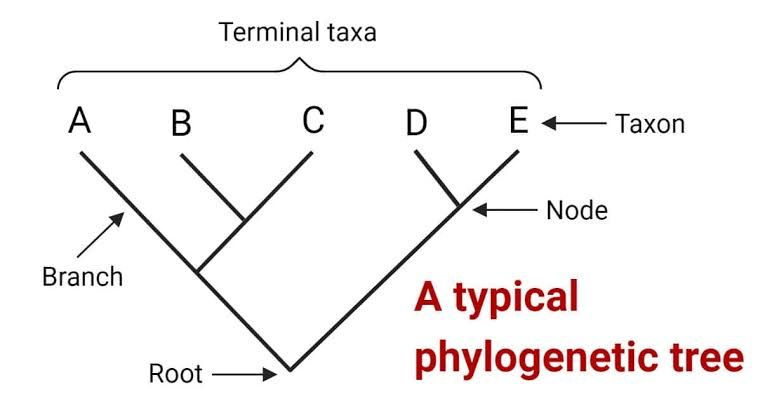
Phylogenetic Analysis and Models of Nucleotide Evolution
Phylogenetic analysis is a method used to infer the evolutionary relationships among various biological species or entities based on their genetic information. This process often involves several models and methods for constructing phylogenetic trees, which visually represent these relationships.
Model of Nucleotide Evolution: Jukes-Cantor
The Jukes-Cantor model is one of the simplest models of nucleotide substitution. It assumes that:
- All nucleotides (A, T, C, G) are equally likely to change into one another.
- The rate of substitution is constant over time.
- The model accounts for the probability of observing a certain number of substitutions between two sequences.
The Jukes-Cantor formula calculates the expected number of substitutions per site (p) as follows:
p=−3/4 ln (1 − 4/3 × q)
where q is the proportion of sites that are different between two sequences.
Molecular Clock Hypothesis
The molecular clock hypothesis posits that mutations accumulate at a relatively constant rate over time in a given lineage. This concept allows researchers to estimate the time since two species diverged by measuring the number of genetic differences between them. The molecular clock can be calibrated using fossil records or known divergence times from other sources.
Methods for Building Phylogenetic Trees
Distance-Based Methods
- UPGMA (Unweighted Pair Group Method with Arithmetic Mean):
- A hierarchical clustering method that assumes a constant rate of evolution (molecular clock). It constructs a tree by grouping pairs of taxa based on their genetic distance until all taxa are included in one tree.
- Neighbor-Joining:
- A distance-based method that does not assume a molecular clock and can handle varying rates of evolution across lineages. It builds trees by iteratively joining pairs of taxa with the smallest distance until all taxa are connected.
Character-Based Methods
- Maximum Parsimony:
- This method seeks to find the tree that requires the fewest evolutionary changes (substitutions) to explain the observed data. It evaluates all possible trees and selects the one with minimal character state changes.
- Maximum Likelihood:
- This approach estimates parameters that maximize the likelihood of observing the given data under a specific model of evolution (e.g., Jukes-Cantor). It uses statistical methods to evaluate how well different trees explain observed genetic data.
Phylogenetic Tree Evaluation and Comparison Strategies
1. Bootstrapping
- A resampling technique used to assess the reliability or support for branches in a phylogenetic tree. By repeatedly sampling from the original dataset with replacement, researchers can generate multiple datasets and reconstruct trees from each, allowing them to estimate confidence levels for each branch.
2. Jackknifing
- Similar to bootstrapping but involves systematically leaving out subsets of data (e.g., certain characters or taxa) to evaluate how much influence those subsets have on tree topology and branch support.
3. Kishino-Hasegawa Test
- A statistical test used to compare two competing phylogenetic trees based on likelihood scores derived from maximum likelihood estimation. It assesses whether there is significant evidence against one tree being more plausible than another given the data.
4. Shimodaira-Hasegawa Test
- An extension of the Kishino-Hasegawa test that allows for more complex comparisons among multiple trees while accounting for potential biases in estimating branch lengths and overall tree topology.
In summary, phylogenetic analysis employs various models like Jukes-Cantor and methodologies such as distance-based and character-based methods to construct evolutionary trees, which can then be evaluated through techniques like bootstrapping and jackknifing, along with statistical tests like Kishino-Hasegawa and Shimodaira-Hasegawa tests.







